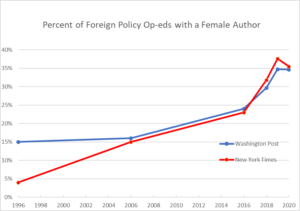Data
A core part of Interruptrr is data tracking. In 2015, in collaboration with Media Matters for America, released the gender breakdown of experts commenting on foreign policy and national security on prime-time cable and Sunday talk shows. We found that in 2015 only 24 percent of those experts were women. In following years, we have seen the number increase by a percentage point.
In 2018, we dived into the op-ed page. More specifically, four op-ed pages: The New York Times, Washington Post, Wall Street Journal, and the Los Angeles Times, across three one-year periods: 1996, 2006, and 2016. Our focus: foreign policy and national security pieces. These pieces spanned global affairs, national security, war, development, human rights, global trade and commerce, bilateral and multilateral issues.
Here’s what we found in 2018:
| 1996 | 2006 | 2016 | TOTAL | |||||
| Women | Men | Women | Men | Women | Men | Women | Men | |
| NYT | 4% | 96% | 15% | 85% | 23% | 77% | 15% | 85% |
| Washington Post | 15% | 85% | 16% | 84% | 24% | 76% | 19% | 81% |
| LA Times | 8% | 92% | 16% | 84% | 17% | 83% | 13% | 87% |
| WSJ | 13% | 87% | 15% | 85% | 12% | 88% | 13% | 87% |
| TOTAL | 8% | 92% | 15% | 85% | 19% | 81% | 15% | 85% |
Here are the recent numbers:
| % of Op-Ed’s with a female author | ||||||
| 1996 | 2006 | 2016 | 2018 | 2019 | 2020 | |
| Washington Post | 15% | 16% | 24% | 30% | 35% | 35% |
| New York Times | 4% | 15% | 23% | 32% | 38% | 35% |
